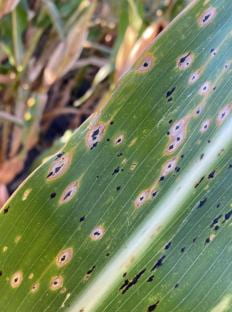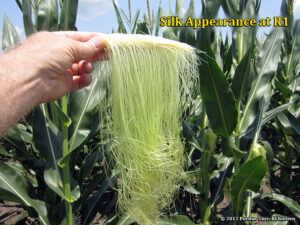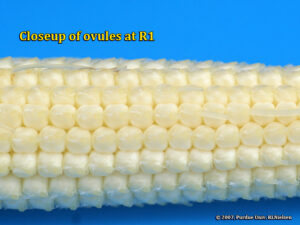
Corn contaminated by vomitoxin
Article is taken from https://agcrops.osu.edu/newsletter/corn-newsletter/2024-24/risk-corn-grain-contamination-vomitoxin-ohio-2024-projection by Pierce Paul, Jason Hartschuh, CCA, Aaron Wilson, Stephanie Karhoff, CCA
This week we continue providing updates pertaining to the projected risk of grain contamination with the mycotoxin deoxynivalenol (DON), which is commonly referred to as vomitoxin. This week, the focus is on fields reaching the silking or R1 growth stage between July 21 and August 4. Using temperature and RH data from CFAES weather stations across the state of Ohio as predictors, the chance (or probability) of vomitoxin contamination of corn grain was estimated using models developed in the Paul lab. Models were run separately on data from each of nine weather stations for 15 silking dates from July 21 to August 4. Predictions generated by these models should only be applied to corn pollinating during the 15-day pre-silking model prediction window, which may be specific for each area of the state and field within that area.
Based on weather data collected from CFAES weather stations located in Ashtabula (LAT: 41.8846, LON: -80.6978), Franklin (LAT: 40.0112, LON: -83.0442), Noble (LAT: 39.7478, LON: -81.5167), Jackson (LAT: 39.0519, LON: -82.6367), Sandusky (LAT: 41.3503, LON: -83.1219), Wood (Latitude: 41.2847, Longitude: -83.8444), Pike (LAT: 39.0681, LON: -83.0144), Clark (LAT: 39.8633, LON: -83.6721), and Wayne (LAT: 40.7787, LON: -81.9308) Counties, OH, grain developing in corn fields in close proximity to the stations that reach the R1 growth stage between July 21 and August 4 are at high risk of being contaminated with at least 1 ppm DON.
Our models were not developed to predict whether vomitoxin will be 2, 5, 8, or 10 ppm, they only predict whether vomitoxin will be ≥ 1 ppm. Whether or not contamination will be considerable higher that 1% will depend on other factors such as hybrid maturity and susceptibility, field location, tillage, and crop rotation, as well as weather conditions. Under favorable weather conditions, a highly susceptible hybrid planted no-till into corn stubble will likely be contaminated with vomitoxin well above 1 ppm compared to a tilled field of a moderately resistant hybrid planted after beans.
These model predictions can be used to help you determine if a fungicide for vomitoxin management would be beneficial. However, no single management strategy will be fully effective again vomitoxin. Even with a fungicide application, hybrid resistance is critical for achieving low vomitoxin levels at harvest. Treated fields planted with partially resistant hybrids will often have lower levels of vomitoxin at harvest than treated fields planted with susceptible hybrids. Two of the most effective products for vomitoxin management are Proline and Miravis Neo. These fungicides tend to be most effective when applied at R1 when silks are still wet. Applications made after silks are dry and brown are considerably less effective at reducing vomitoxin. The fungicide must penetrate the canopy and reach the corn silks to be effective.
These models are the first step towards the development of a prediction tool that would be available to growers to run on a daily basis during pollination to assess vomitoxin risk at their field location. The current model development has been generously supported by the Corn Marketing Board through your corn check-off. As more data are collected, models will be developed to predict the risk of higher levels of contamination (2 ppm, 5 ppm, etc etc).
More information on vomitoxin risk assessment and management in corn can be found in this corn newsletter article: https://agcrops.osu.edu/newsletter/corn-newsletter/2024-22/risk-corn-grain-contamination-vomitoxin-ohio-2024-july-8
Estimates of the risk of DON contamination of corn grain are provided at no cost within the state of Ohio. The model developers, The Ohio State University, and funding agencies cannot guarantee prediction accuracy. Users should always consult extension educators and state and field specialist when making disease and mycotoxin management decisions.










 Due to popular demand, the AgCrops Team will host the 2nd annual virtual Corn College and Soybean School on February 15, 2022, from 9:00 AM – 4:00 PM featuring your OSU Extension state specialists, including the new corn agronomist, Dr. Osler Ortez, and new soybean pathologist, Dr. Horacio Lopez-Nicora. CCA CEUs will be available during the live presentations. The cost of the program is $10. To register go to
Due to popular demand, the AgCrops Team will host the 2nd annual virtual Corn College and Soybean School on February 15, 2022, from 9:00 AM – 4:00 PM featuring your OSU Extension state specialists, including the new corn agronomist, Dr. Osler Ortez, and new soybean pathologist, Dr. Horacio Lopez-Nicora. CCA CEUs will be available during the live presentations. The cost of the program is $10. To register go to 




